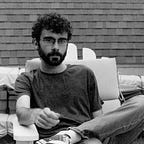Sentimental Sewing: The Stories That Made A Museum
“It was the first inanimate object I had a moment with,” said Wayne “W.K.” Binger as he leaned over Lucy, his 201–2 Singer sewing machine. Lucy rests atop a wooden sewing table in front of a Lucy Ricardo mural–an association, Wayne explained, that came after he spontaneously named her. As a man, he mentioned, he thought he could clean and buff the machine as he could his Mercedes-Benz, but his “man” approach resulted in the erasure of the intricate gold decals that contoured the cast iron plate. With dramatic fashion, he recalled his disbelief by exclaiming “Oh baby!”, reaching his arms out towards Lucy.
Lucy is not Wayne’s only inanimate love; over the past three years, people from all over the world have donated their sentimental sewing machines, each one holding a unique and passionate story Wayne knows by heart. Wayne runs the Vintage Sewing Machine Museum–sometimes referred to as the “M”–just south of downtown Tulsa, Oklahoma, bordering the Arkansas River. Though his museum houses some of the rarest–and often the world’s only–machines, money is the very last thing he wants, appearing quite disgruntled whenever referencing the subject. I arrived with my domestic partner, Katie, at the museum entrance–guarded by an iron arbor made of sewing machines. Wayne peeked around the corner of his museum.
“You’re in luck! I was just fixin’ to leave,” he called out at us. “Go on inside!”
Wayne turned around and disappeared behind the small, single-story museum. Katie and I shuffled inside. A waft of metallic, leathery, and slightly musty air enveloped our olfactory. Gravitating towards the entrance, we waited a few minutes until Wayne arrived and officially greeted us; though greeting is a bit of a strain, he immediately went into reciting stories. For a man set to leave, I never expected four hours of story-telling–even going beyond the museum’s closing hours.
The museum curator sported an uneven white mustache that curved–like a parabola–inward towards his chin and wore an off-white wool sweater. His face showed the leathery wear of an outdoorsman and the callused hands of a restless tinkerer. He claims a preference towards true privacy, however, because of the depth of his stories and the personal tangents he embarks on, I find this declaration hard to swallow. For example: before mentioning the hundreds of sewing machines surrounding us, he beckoned us over to a handmade wooden broom resting by the entrance and described his brief life as a broom maker in Brunswick, Georgia; though not before revealing the death of his young wife to a fatal aneurysm–later isolating himself to a log cabin for eight years. A further tangent brought us to the uncomfortable moment where Wayne took a .45 pistol from behind the counter and told us the moments he used it–including the first time he wanted to kill someone (the individual in question shot three people — including Wayne in the face). Each story was a play, outfitted with props and theatrics; it became evident that Wayne was the attraction.
As an arborist, engineer, and general handyman in the deep South–other long-winded stories I will not go into–it seemed peculiar that he would end up a founder to a sewing museum. As in his nature, he had a long story for this, too. His collection started though a simple request by a retired Singer repairman: to find homes to two Singer 99 machines. He came across this repairman by the suggestion of a customer at a fabric store after seeking and failing to reupholster a boating chair. The repairman had contacts with many individuals seeking to re-home their machines and quietly put the responsibility on Wayne–who quickly received a multitude of calls to re-home Singers. Wayne’s approachable demeanor and ability to listen encouraged those to reveal the intimate stories behind each machine and respectfully keep and retells them to those who visit. His collection has expanded to nearly five hundred Singers and uses the museum as a playground for girl scouts and many others to continue using the machines as originally intended. Wayne went as far as to create a children’s sewing room, outfitted with a sewing machine built for an original munchkin from the Wizard of Oz.
Wayne expanded his collection with a few musical instruments. He demonstrated a Dulciphone for us–an organette using a perforated paper roll akin to a self-playing piano to play music. With perfect expertise, he rotated a crank attached to the paper roll to generate sound — lifting a wooden prism and a lid to change the pitch. Wayne also restored a Brunswick Phonograph from a castle in England. The phonograph stopped working after the owner’s parent’s wedding and still held the couple’s record since then. After restoration, the phonograph played Glen Miller’s Moonlight Serenade for the first time. The vinyl 45 record scratched and popped as the needle glided across its grooves–however, the imperfections failed to lessen the emotional impact of arguably one of the world’s most romantic songs.
The museum Wayne created is less about the sewing machines, but the stories behind them. The stories are a large proponent in the decision to refuse generous offers from other museums–like the Smithsonian–as donators entrusted him to keep the sentimentality of each machine alive. Before Wayne collected sewing machines, he thought of inanimate objects as purely utilitarian, but now understands that once he gives a sewing machine to a new owner without the context of its past, it loses all sentimental value. What separates a sewing machine from its utilitarian function is the stories of the owner–a value that can only be maintained by sharing with others.
